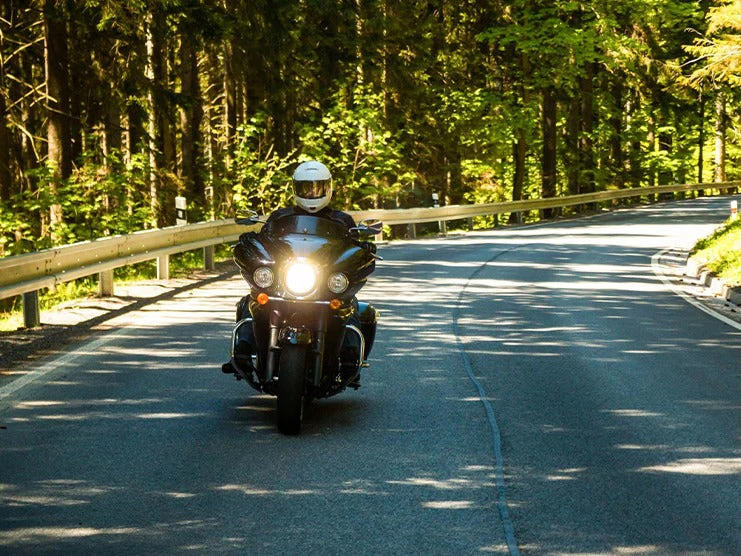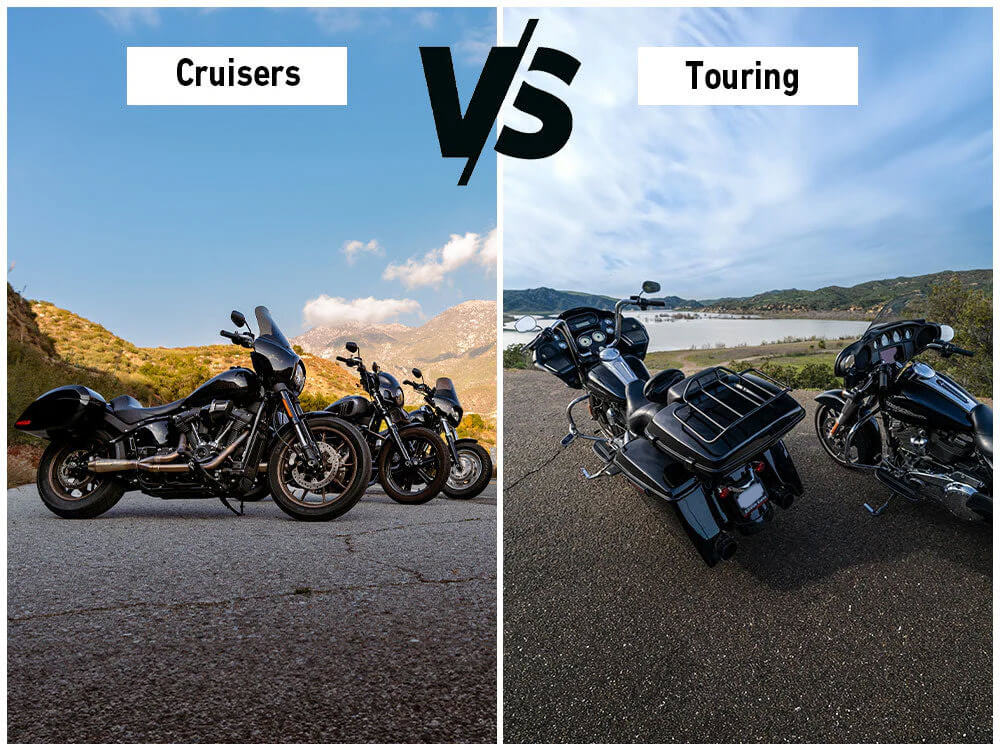Going on a long motorcycle trip can be an exciting and unforgettable experience. However, to ensure that your trip goes smoothly, it is crucial to prepare your motorcycle beforehand. Preparing your motorcycle for long trips involves more than just filling up the gas tank and hitting the road.
This article discusses 10 tips to prepare any motorcycle for long trips.
Table of Content

1. Tips to Prepare Any Motorcycle for Long Trips
1.1 Inspect the Motorcycle Before the Trip
The importance of servicing motorcycles before a long trip can’t be denied. Everything you do before a trip helps you during the trip. Every motorcycle part such as oil and air filters, spark plugs, sprockets, brake pads, drive chain, tires, and the battery needs to be thoroughly checked and tuned before going on a long trip. If there is any indication that any motorcycle parts are showing signs of malfunctioning, repair or replace it immediately. Applying maintenance before the trip can eliminate 90% of possible mechanical problems.
Before every long motorcycle trip, make sure to check the following motorcycle parts:
Oil
Motorcycle engines need fresh oil for optimal functionality. It’s recommended you change the oil at least once per year. But if you’re planning a long trip, it’s prudent to check the oil level often and refill it if it’s low.
Brakes
Check the brakes to make sure they activate when the brake lever is applied and are the most crucial safety feature. It’s important to keep them in working condition.
Tires
Inspecting the tires for wear and tear before a long trip helps you avoid problems during the trip. Check the tire treads and walls for any punctures and apply repairs. Also, make sure the tires are inflated to the right pressure. Poorly inflated tires can result in a blowout.
Fuel and Air Filters
The fuel and air filters can affect your motorcycle’s performance. If the filters are not cleaned, fuel and air will not be able to pass through to the engine. Check the filters and clean them before a trip.
Drive Chain
The drive chain transfers engine power to the back wheel. Make sure it is properly lubricated and moves smoothly when the motorcycle moves before going on a long trip.
Battery
Check the current charge of the motorcycle battery and recharge it back to full power if necessary before a long trip.
1.2 Carry Spare Parts
Carrying spare parts ensures that you can replace any faulty components yourself during the trip instead of being stranded along the road or needing to go to a mechanic.
Doing research about your specific model, including the serial numbers for its parts and the location of the weak points, and what spare parts you might need.
It is recommended you carry the following spare parts on a long motorcycle trip:
- Brake Pads
- Chain
- Fuel Pumps
- Fork Seals
- Sprockets
- Clutch Pedals
- Inner Tubes
- Wheel Bearings
- Clutch Cable
- Fuses
- Oil Filters
1.3 Comfort is Everything
Comfort is a top priority for most riders when going on a long trip. Most riders think that having a comfortable seat is enough. But to improve your motorcycle’s comfort level, you must install the proper seat, handlebars, footpegs, windshields, hand guards, heated grips, backrests, and padded grips.
Handlebars
Adjust the handlebar's height to a position that makes it easy for you to grab the handles without having to slouch or stretch too far. The types of handlebars include tracker handlebars, butterfly bars, clip-on handlebars, motocross handlebars, Z-bars, and ape-hangers. Choose the handlebars that best suit your riding style and offer the most comfort.
Foot Pegs
Install wider foot pegs on your motorcycle so that there is more room to rest your feet and make it easier to control your motorbike.
Wind Shield
Wind protection is essential on a long trip, especially if riding on highways. Windshields protect you from incoming wind and help minimize strain on your arms, back pain, and fatigue.
Hand Guards
Hand guards help protect the brake lever, clutch lever, and your knuckles. In case of a collision, the hand guards will keep the brake or clutch levers from being destroyed.
Heated Grips
Heated grips will help keep your hands warm if riding in cold temperatures, especially in the early morning or late evening.
Padded Grips
Padded grips reduce wrist fatigue and pain during long motorcycle rides. It also provides extra cushioning for your hands that will keep them from being hurt due to gripping the throttle for hours.
Backrest
A backrest supports the lower back, prevents back pain, prevents leg cramps, and provides more comfort throughout a ride. A backrest can also protect your back in case your motorcycle is hit from behind.
1.4 Navigation
Use a GPS or your mobile phone to help map out your route. The most suitable place to place a GPS is above the dashboard as long as it does not block your view of the road ahead. You can also attach a GPS to the middle or sides of the handlebars. However, this isn't an ideal position since it is difficult to look back and forth between the road and the GPS. Having to look at the GPS may distract you and increase the risk of getting into an accident.
1.5 Luggage
Depending on the length and nature of your trip, you will need to use specific luggage bags. Most riders prefer hard panniers because they are lockable and have a low center of gravity. However, they require a luggage rack to be mounted, adding an additional 20 kg to the motorcycle’s weight. Extra weight will affect your motorcycle’s performance, handling, and fuel economy. For longer trips, it is best to use soft luggage bags.
1.6 Safety
Listed below are ways you can improve safety on the road:
Tires
Make sure your motorcycle is fitted with tires appropriate to the road conditions you will be traveling on. When choosing tires, keep the terrain you’ll be going through in your mind. Tires are what keep you straight and safe on the road. Your motorcycle’s tires should have excellent traction, be able to handle heavy loads and have a durable build to provide more mileage and reduce wear and tear.
Brake Pads
Brake pads press against the brake rotors and help slow your motorcycle when you press the brake lever. Before going on a long trip, check the brake pads for any faults and ride your motorcycle a short distance to evaluate its braking capability. If they have become worn out or faulty, replace them as soon as possible with good-quality brake pads.
1.7 Motorcycle Security
If you're traveling to a new location, you can use various locks to keep your motorcycle secure, such as disc locks, chain and locks, cable locks, brake lever locks, and ground anchors. Also, using a motorcycle cover and parking your ride in a hard-to-reach or public place can help discourage thieves from trying to steal your motorcycle.
1.8 Accessories
Having accessories installed on your motorcycle can help make your trip more comfortable and relaxing.
Cruise Control
Cruise control allows you to set the throttle at a specific speed so you do not have to constantly adjust it by hand. You can increase or decrease the speed by pushing the switch up or pressing it down.
Tank Bags
Tank bags are fitted on top of the fuel tank with the help of magnets or straps. They offer additional storage capacity to help you carry other belongings. They are easy to access and can store your water bottle, snacks, mobile phone, gloves, etc.
Saddlebags
Saddlebags have a rigid-mount structure or can be attached using mounting straps. They provide extra storage space for your luggage and are placed along the sides of the motorcycle’s rear end. They are easy to install and release and have multiple pockets to store your belongings.
Tail Bags
Tail bags are attached to the motorcycle’s rear end above the rear wheel and offer plenty of extra storage space. They have exterior pockets, side pockets, a waterproof cover, and a large main compartment.
1.9 Check the Lights
Check the headlights, taillights, turn signals, and brake lights to ensure they are visible, especially at night.
1.10 Check the Cooling System
Long trips can put more stress on your motorcycle's cooling system. Check the coolant level, inspect the hoses for leaks or damage, and clean the radiator fins if necessary. Any fault in the cooling system can cause it to overheat which can affect the engine’s performance.
2. Last Words
When preparing your motorcycle for a long trip, you must pay attention to detail and be thorough when inspecting your ride. You may need to change the oil, inspect the tires, test the brakes, check the battery, inspect the chain and sprockets, install navigation, check the cooling system, check the lights, pack luggage bags, and bring the right gear to ensure a safe and enjoyable trip. Remember to ride defensively and stay alert while on the road












Leave a comment
All comments are moderated before being published.
This site is protected by hCaptcha and the hCaptcha Privacy Policy and Terms of Service apply.